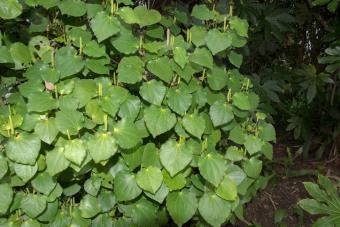
The Maori people have used the medicinal herbs of New Zealand for thousands of years to treat and prevent illness. According to Te Ara, the Encyclopedia of New Zealand, colonization by Europeans had a profound impact on traditional medicine in the region. This important aspect of Maori culture may have been lost, but a number of factors brought about a revival of the practice of Rongoa, or traditional Maori medicine, late in the twentieth century up to the present. Today, ethnobotanists and modern herbalists work with Maori tohunga ahurewa, or priestly experts, to record the ancient knowledge of medicinal plants in the region.
New Zealand's Most Common Medicinal Herbs
As the result of a few dedicated individuals, traditional herbal lore is being supported by scientific research. According to Te Ara, the Maori traditionally used over 200 plant species for medicinal purposes. Many of the most common of these medicinal plants have been studied scientifically, and many other possibilities are waiting to be explored. Some of the most commonly used medicinal herbs of New Zealand include the following:
Harakeke (flax)

Traditionally, this plant has been utilized for both medicinal properties and as a source of fiber. Several parts of the plant are used as medicine according to Landcare Research.
- Leaves are used to create splints for injured arms or to treat wounds.
- Roots are often prescribed to treat intestinal parasites. This practice has been investigated by at least one study, using heifer calves as test subjects, and researchers found no difference in fecal egg counts between test subjects and untreated control animals.
- Rhizomes or root base are used as a poultice for boils.
- Gum or resin are used to treat wounds (especially gunshot wounds) and scalds, as well as toothaches.
There are many other cures for this versatile plant when mixed with ingredients from other plants.
Kawakawa (Pepper Tree)

The pepper tree is one of the most widely used indigenous medicinal plants of New Zealand. NW Times reports that tohunga commonly prescribe this plant for the following maladies:
- Stomachache: Leaves and bark of the tree can be chewed or used as tea to treat stomach ache or dysentery.
- Toothache: Leaves are chewed or applied as a poultice
- Cuts: The liquid from boiled pepper tree leaves can be applied to a cut to speed healing and prevent infection.
- Rheumatism: Leaves of the plant are used topically to treat rheumatism.
- Sexually Transmitted Diseases: A more recent use for the plant, after the European colonization of New Zealand, Tohunga began prescribing steam baths and using Kawakawa to treat many of the sexually transmitted diseases introduced by European colonists.
Rata

This well-known tree, a member of the myrtle family, may be cultivated for its ornamental value as well as for potential medicinal properties. Landcare Research lists the following medicinal uses:
- Bark: Traditionally, Maori people would steep the bark of this tree in water and then use the resulting liquid as a lotion to speed wound healing and prevent infection. The liquid could alternatively be used as a beverage to treat dysentery and other digestive complaints.
- Flowers: In combination with honey, the flowers are used for sore throats.
Manuka

Also known as New Zealand Tea Tree, this plant should not be confused with the narrow-leaved tea-tree, the source of tea tree oil. Manuka has a long history of medicinal use notes Museum of New Zealand, and they are:
- Ashes: Skin disorders can be treated by rubbing the ashes of burnt manuka on the skin.
- Bark: Infusion made from the bark is used as a sedative and to treat burns. The inner bark boiled in water is used as mouthwash.
- Leaves: Inhalation of leaves placed in boiling water is used for cold.
- Manuka Honey: In recent years, manuka has gained attention, not for the properties of its leaves or bark, but for a tea made from its nectar. Specifically, honey that the honey bees produce using nectar from the manuka tree has shown remarkable antibiotic properties, reports WebMD. It can be used to treat minor wounds and cuts and fight infection. Initial studies indicate that manuka honey may be useful in treating gingivitis and other dental diseases.
Modern Medicine May Catch Up to Maori Healers
Much like the tropical rainforests of other regions, the temperate rainforests of New Zealand are home to an amazing diversity of plant species. While modern medicine has only begun to explore the potential properties of these plants, the medicinal herbs of New Zealand have already enjoyed a long and interesting history with Maori healers.







